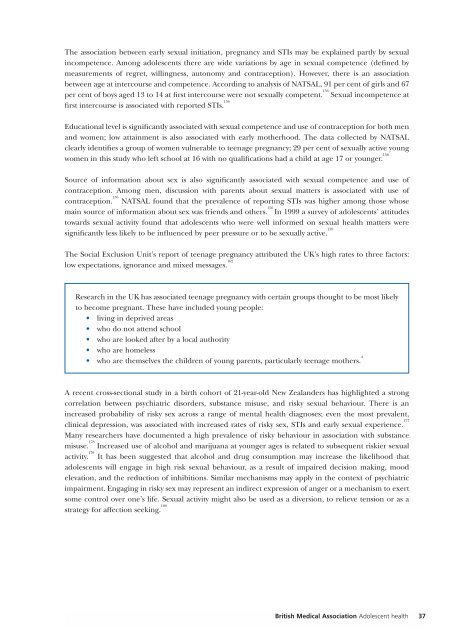Alcohol misuse: tackling the UK epidemic - London
Alcohol misuse: tackling the UK epidemic - London
Alcohol misuse: tackling the UK epidemic - London
You also want an ePaper? Increase the reach of your titles
YUMPU automatically turns print PDFs into web optimized ePapers that Google loves.
The association between early sexual initiation, pregnancy and STIs may be explained partly by sexual<br />
incompetence. Among adolescents <strong>the</strong>re are wide variations by age in sexual competence (defined by<br />
measurements of regret, willingness, autonomy and contraception). However, <strong>the</strong>re is an association<br />
between age at intercourse and competence. According to analysis of NATSAL, 91 per cent of girls and 67<br />
per cent of boys aged 13 to 14 at first intercourse were not sexually competent. 156<br />
Sexual incompetence at<br />
first intercourse is associated with reported STIs. 156<br />
Educational level is significantly associated with sexual competence and use of contraception for both men<br />
and women; low attainment is also associated with early mo<strong>the</strong>rhood. The data collected by NATSAL<br />
clearly identifies a group of women vulnerable to teenage pregnancy; 29 per cent of sexually active young<br />
women in this study who left school at 16 with no qualifications had a child at age 17 or younger. 156<br />
Source of information about sex is also significantly associated with sexual competence and use of<br />
contraception. Among men, discussion with parents about sexual matters is associated with use of<br />
contraception. 156<br />
NATSAL found that <strong>the</strong> prevalence of reporting STIs was higher among those whose<br />
main source of information about sex was friends and o<strong>the</strong>rs. 156<br />
In 1999 a survey of adolescents’ attitudes<br />
towards sexual activity found that adolescents who were well informed on sexual health matters were<br />
significantly less likely to be influenced by peer pressure or to be sexually active. 159<br />
The Social Exclusion Unit’s report of teenage pregnancy attributed <strong>the</strong> <strong>UK</strong>’s high rates to three factors:<br />
low expectations, ignorance and mixed messages. 162<br />
Research in <strong>the</strong> <strong>UK</strong> has associated teenage pregnancy with certain groups thought to be most likely<br />
to become pregnant. These have included young people:<br />
• living in deprived areas<br />
• who do not attend school<br />
• who are looked after by a local authority<br />
• who are homeless<br />
• who are <strong>the</strong>mselves <strong>the</strong> children of young parents, particularly teenage mo<strong>the</strong>rs. 4<br />
A recent cross-sectional study in a birth cohort of 21-year-old New Zealanders has highlighted a strong<br />
correlation between psychiatric disorders, substance <strong>misuse</strong>, and risky sexual behaviour. There is an<br />
increased probability of risky sex across a range of mental health diagnoses; even <strong>the</strong> most prevalent,<br />
clinical depression, was associated with increased rates of risky sex, STIs and early sexual experience. 177<br />
Many researchers have documented a high prevalence of risky behaviour in association with substance<br />
<strong>misuse</strong>. 178<br />
Increased use of alcohol and marijuana at younger ages is related to subsequent riskier sexual<br />
activity. 179<br />
It has been suggested that alcohol and drug consumption may increase <strong>the</strong> likelihood that<br />
adolescents will engage in high risk sexual behaviour, as a result of impaired decision making, mood<br />
elevation, and <strong>the</strong> reduction of inhibitions. Similar mechanisms may apply in <strong>the</strong> context of psychiatric<br />
impairment. Engaging in risky sex may represent an indirect expression of anger or a mechanism to exert<br />
some control over one’s life. Sexual activity might also be used as a diversion, to relieve tension or as a<br />
strategy for affection seeking. 180<br />
British Medical Association Adolescent health 37
















